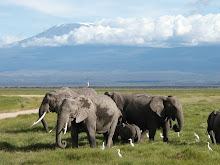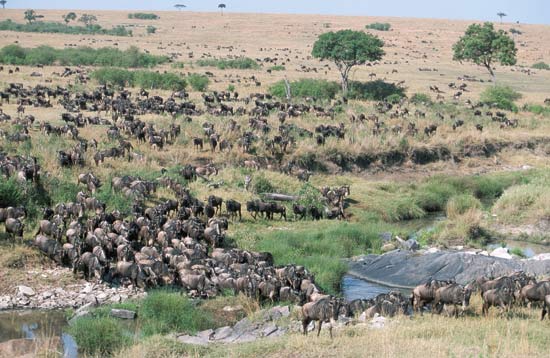Adventure Africa Holidays is a specialist tour operator with its office headquarters in Nairobi, Kenya but operating throughout East Africa. We offer Masai Mara Serengeti Wildebeest Migration Safari, Serengeti Masai Mara annual wildebeest migration Masai Mara Wildebeest Migration, Maasai Mara Migration Safari, Wildebeest migration safari in Masai Mara Kenya
Masai Mara Wildebeest Migration Overview:
May & JuneIn late May, the herds leave the Western Corridor for the northern Serengeti plains and woodlands. The fresh, tender and mineral-rich pastures on the other side of the humans' border, in Masai Mara, are the irresistible bait for the animals to finally invade the Kenyan reserve, an event which usually starts in late June to early July. The troops coming from the south meet here another migratory contingent: the resident wildebeest herds of the Mara region. These animals reside in the Loita Plains and Hills, northeast of the Mara, until the dry season brings the tougher days and it is time to seek the evergreen Mara basin.
July to OctoberThroughout the month of July, the herds cross the Sand River, a mostly dry tributary of the Mara which roughly follows the boundary line between Kenya and Tanzania. The parade takes the eastern sector of Masai Mara, surrounding the Keekorok Lodge area. The trek follows westward, leading the herds to face the major challenge along their quest: crossing the Mara river and frequently also its tributary, the Talek. By then, the rains at the Mau Escarpment, where the Mara rises, have fed the stream to its highest levels. The steep banks are populated with trunk-looking basking crocodiles that seem almost to be expecting their annual banquet. The operation of fording the river is the most delicate along the migration, and as such seems to plunge the gnus in a state of anxiety that only relieves when the whole herd has crossed. The trekkers walk along the left (eastern) bank of the Mara looking for a suitable point to cross. There are plenty of preferred crossings along the course, which are easily identifiable by the lack of vegetation, the depressed slopes and the deep grooves carved by the animals' hooves. These are the most secure places to ford the river, those that ensure a minimal mortality. Nonetheless, the apparent programming of the whole process sometimes seems to collapse, and the nervous herds occasionally choose places where the banks are too steep and many of the animals break their legs down the cliff or fall flat into the waters. The herds gather at the suitable points and wander around nervously, their grunts sounding loud in the air. Eventually, one animal takes the lead and approaches the rim, scanning the opposite edge to analyze if any danger awaits after the crossing. When it finally dives into the stream, this seems to haul the rest of the herd. More animals follow in a single line across the river, while the lagged ones throw themselves towards the stream until the rearguard pushes the troops to a frantic race that ends up with some animals trampled to death, lying aside the course. Along the boreal summer, the crossings repeat over and over, and the survivors graze peacefully on the Mara Triangle grasslands unless disturbed by the early-morning and late-evening hunts of lion and cheetah, the latter preying on the calves.
By October, the rains are heading south back to the Serengeti. This is when the pace of the march reverses, bringing the herds to face once more the quest for the southern grasslands. The rite of fording the river is again part of nature's call. In the last days of October, the migration heads towards the vast plains of the southern Serengeti, where a new generation of calves will be born to start the cycle of life all over again. Normally the route is down the eastern side and the pace is fast. Quite often a million animals can be seen stretched out.
Check out available wilbebeest migration safaris: http://www.adventureafricaholidays.com/masaimaramigrationsafari.html
Also, you may sample all tours available in both Kenya and Tanzania:
Kenya safaris: http://www.adventureafricaholidays.com/kenyaluxurylodgesafaris.html
Tanzania safari tours: http://www.adventureafricaholidays.com/tanzanialuxurylodgesafaris.html
Masai Mara Migration safaris and Serengeti Migration tours: Wildbeest mogration safaris in Kenya and Tanzania
Kenya Tanzania safari African Holidays Wildlife Safaris Kenya Tanzania Tour trips and holidays with adventureafricaholidays.com: African Exclusive safaris to Kenya and Tanzania Safari holidays, Kenya Safari under canvas trips, Tanzania Tours and adventure trips Vacations



